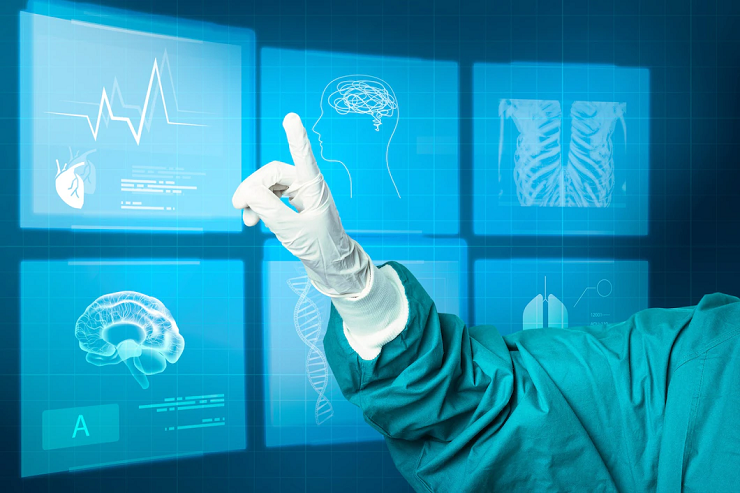
The healthcare sector is changing dramatically with the help of various cutting-edge digital technologies, such as artificial intelligence (AI), 3D printing, robotics, and nanotechnology. The sector has become familiar with the most recent technological advancements, but there is still a long way to go. Since the pandemic, it has become abundantly clear how technology has the potential to significantly influence how healthcare facilities are designed, improved, and brought into the new digital era.
Today’s cutting-edge technological trends are revolutionizing how medical professionals deliver care. We’re on the verge of revolutionary developments that will change biotechnology and healthcare. Several technologies have advanced significantly, including wearable technology, artificial intelligence (AI), and telemedicine.
1. Online Education And Technology
Technology has a wide range of effects on medical education. For one thing, students are no longer restricted to attending local medical colleges by taking online courses. They have access to educational institutions and training programs all over the world. Online education is more flexible in addition to being very accessible. It accommodates the hectic schedules of healthcare professionals, enabling them to learn whenever and wherever they want.
Second, virtual reality is crucial to the education of healthcare professionals. They can turn a space into an operating room. Students can practice in this way.

2. Artificial Intelligence
Do not worry if you still fear that artificial intelligence will take your job. There is little chance that robots will replace physicians and surgeons if you go to the Will Robots Take My Job website and perform a search for that term. Although AI cannot replace your job, it can make it better. The healthcare industry is changing due to various AI technologies, including task automation, machine learning, and natural language processing. These technologies can be used in multiple healthcare specialties, including immunology and pediatrics. The best thing about AI is how it gathers, processes, and turns enormous amounts of data into insightful knowledge. It is essential for detecting diseases in their early stages. That is especially pertinent to services that provide pink screening, like mammography.
Read Also- Top Ways For Small Businesses To Adopt AI
3. Wearable Medical Tech
Mobile technology devices that people can wear, like Fitbits and smartwatches, make up wearable medical equipment. They are designed to collect particular health and fitness information from wearers. These gadgets have become so commonplace in our daily lives that they are now considered mainstream. The success of the wearable technology market and consumer desire to take charge of their health is to blame for this.
When you hear about wearable medical devices, one of the first things that come to mind are fitness trackers—wristbands with sensors that track and alert about the wearer’s health data, such as the number of calories burned or heart rate. They can offer a tonne of fitness and health advice combined with a smartphone app.

Next, smartwatches are now popular health accessories. They not only track steps and display the time but also offer invaluable health-related data like warnings when atrial fibrillation is present. Because they can generate electrocardiograms, wearable ECG monitors are more technologically advanced than smartwatches. The wearable blood pressure monitor, which adds blood pressure to daily activity information like steps and calories, is another device resembling a smartwatch.
Many healthcare and biotech companies have invested in wearable healthcare devices due to the devices’ increasing popularity. This enables medical professionals to keep tabs on the health of high-risk patients and avert difficult medical situations that might harm them. Additionally, they can gamify the healthcare experience, offer insurance incentives, and personalize the patient experience.
Read Also- Top 6 Wearable Technology Trends You Must Know Right Now
4. Clinical Trials
Research that examines novel procedures and therapies and assesses how they affect patient outcomes is known as clinical trial research. People voluntarily participate in clinical trials to investigate various medical treatments, such as medications, cells, and other biological products, surgical and radiological procedures, devices, behavioral therapies, and preventive care. Using AI-enabled digital health technologies and patient support platforms, clinical trials can be revolutionized with improved success in luring, enticing, and holding on to committed patients throughout the study and, after analysis, termination. Numerous sponsors also employ CROs in clinical trials.

A CRO’s ability to successfully navigate changes depends on how they modify their methods and strategies to be more flexible and effective. The CRO industry is constantly changing. The ideal CRO digital platform offers the opportunity to lessen the administrative burden currently placed on sites and to move data capture and integrity directly into the digital ecosystem, allowing for earlier intervention, if necessary, or more rapid trial completion to support registration or go/no-go decisions.
These improvements will require organizational change and leadership vision to propel the CRO transformation. Cloud technologies and digital and cognitive automation best solve the sponsor-CRO challenges. Better Clinical Trial operation management, a shorter time to market, and, most importantly, ensuring patient access to better and more potent products and treatments are all benefits of this combination.
5. 3D Printing
The healthcare sector has been elevated to a whole new level by 3D printing. It allows healthcare organizations to save time and money. These technologies enable businesses to produce prosthetics, supports, and artificial bones. Even creating transplants and repairing damaged tissue is possible with 3D printing. This technology has enormous potential.
Wrapping Up
By providing quality healthcare to billions of people and enabling current healthcare facilities to meet rising demand, these innovations have enormous potential. Healthcare and biotech companies must assess how these technologies affect their business practices. To maintain their profitability and competitiveness, they must invest in cutting-edge solutions. It will be intriguing to see where these businesses go with these new technological developments in the present and the future.
